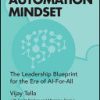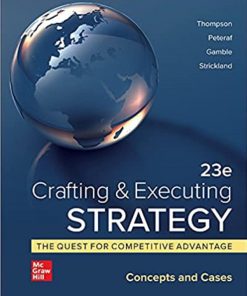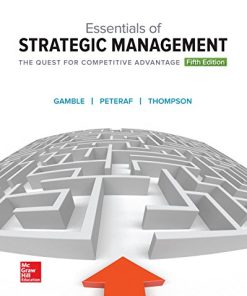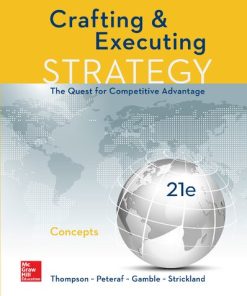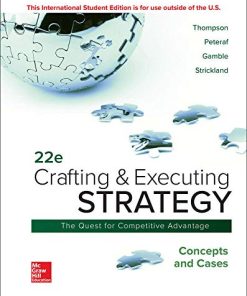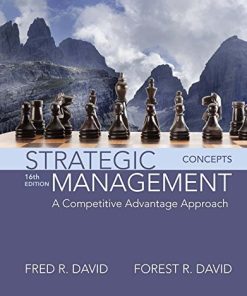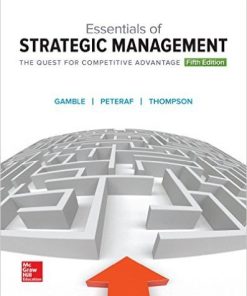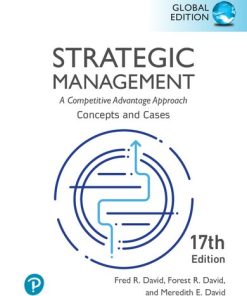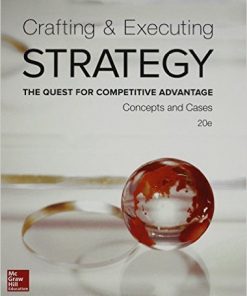(EBOOK PDF)Crafting and Executing Strategy Concepts and Cases ISE The Quest for Competitive Advantage 23rd Edition by Margaret Peteraf 9781264364732 1264364733 full chapters
$50.00 Original price was: $50.00.$25.00Current price is: $25.00.
Crafting and Executing Strategy Concepts and Cases ISE The Quest for Competitive Advantage 23rd Edition by Margaret Peteraf – Ebook PDF Instant Download/Delivery: 9781264364732, 1264364733
Full download Crafting and Executing Strategy Concepts and Cases ISE The Quest for Competitive Advantage 23rd Edition after payment
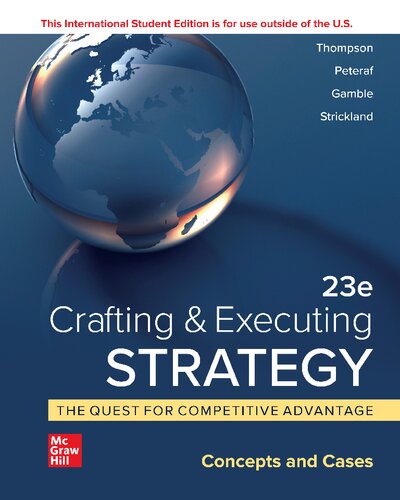
Product details:
• ISBN 10:1264364733
• ISBN 13:9781264364732
• Author:Margaret Peteraf
Crafting & Executing Strategy: Concepts and Cases ISE
The Quest for Competitive Advantage
Crafting & Executing Strategy: The Quest for Competitive Advantage: Concepts & Cases 23e has a long-standing reputation of being the most teachable text. It is regarded as the benchmark by which all others are measured. It is engaging, clearly articulated and conceptually balanced mainstream treatment of the latest developments in theory and practice include the clearest presentation of the value-price-cost framework. Our co-author, Margaret Peteraf, a highly regarded researcher, helped integrate both the resource-based view of the firm from the perspective of both single-business and multi-business strategies. Chapter content is tightly linked to the 27 high-interest cases, most of which are written by the text authors, and receive high acclaim for student appeal, teachability and suitability. McGraw Hill’s Connect® online homework and learning solution for the 23rd Edition has been bolstered to support faculty teaching hybrid and online courses. Connect allows adopters to easily integrate auto-graded content using Connect or your Learning Management System to assess student mastery of course competency goals. The 23E of Connect offers automatic grading for all chapter quizzes, learning assurance exercises, and virtually all exercises for simulation users for 12 chapters. In addition, Connect includes auto-graded case exercises for 14 of the 27 cases included in the text. Plus, Connect provides a wide variety of learning resources that take your students higher by developing students’ lower-to higher order thinking skills, aligned with Bloom’s Taxonomy including: SmartBook 2.0’s adaptive reading experience, Whiteboard Video Cases, Case Analyses, Application-Based Activities (mini-simulations), Writing Assignments, and more.
Crafting and Executing Strategy Concepts and Cases ISE The Quest for Competitive Advantage 23rd Table of contents:
Part 1: Concepts and Techniques for Crafting and Executing Strategy
Section A: Introduction and Overview
Chapter 1: What Is Strategy and Why Is It Important?
What do We Mean by Strategy?
Strategy Is about Competing Differently
Strategy and the Quest for Competitive Advantage
1.1 Apple Inc.: Exemplifying a Successful Strategy
Why a Company’s Strategy Evolves over Time
A Company’s Strategy Is Partly Proactive and Partly Reactive
Strategy and Ethics: Passing the Test of Moral Scrutiny
A Company’s Strategy and Its Business Model
What Makes a Strategy a Winner?
1.2 Pandora, SiriusXM, and Over-the-Air Broadcast Radio: Three Contrasting Business Models
Why Crafting and Executing Strategy are Important Tasks
Good Strategy + Good Strategy Execution = Good Management
The Road Ahead
Chapter 2: Charting a Company’s Direction
What does the Strategy-Making, Strategy-Executing Process Entail?
Stage 1: Developing a Strategic Vision, Mission Statement, and Set of Core Values
Developing a Strategic Vision
Communicating the Strategic Vision
2.1 Examples of Strategic Visions—How Well Do They Measure Up?
Expressing the Essence of the Vision in a Slogan
Why a Sound, Well-Communicated Strategic Vision Matters
Developing a Company Mission Statement
Linking the Vision and Mission with Company Values
2.2 TOMS Shoes: A Mission with a Company
Stage 2: Setting Objectives
Setting Stretch Objectives
What Kinds of Objectives to Set
The Need for a Balanced Approach to Objective Setting
2.3 Examples of Company Objectives
Setting Objectives for Every Organizational Level
Stage 3: Crafting a Strategy
Strategy Making Involves Managers at All Organizational Levels
A Company’s Strategy-Making Hierarchy
Uniting the Strategy-Making Hierarchy
A Strategic Vision + Mission + Objectives + Strategy = A Strategic Plan
Stage 4: Executing the Strategy
Stage 5: Evaluating Performance and Initiating Corrective Adjustments
Corporate Governance: The Role of the Board of Directors in the Strategy-Crafting, Strategy-Executing Process
2.4 Corporate Governance Failures at Volkswagen
Section B: Core Concepts and Analytical Tools
Chapter 3: Evaluating a Company’s External Environment
Assessing the Company’s Industry and Competitive Environment
Analyzing the Company’s Macro-Environment
3.1 The Differential Effects of the Coronavirus Pandemic of 2020
Assessing the Company’s Industry and Competitive Environment
The Five Forces Framework
Competitive Pressures Created by the Rivalry among Competing Sellers
The Choice of Competitive Weapons
Competitive Pressures Associated with the Threat of New Entrants
Whether Entry Barriers Are High or Low
The Expected Reaction of Industry Members in Defending against New Entry
Competitive Pressures from the Sellers of Substitute Products
Competitive Pressures Stemming from Supplier Bargaining Power
Competitive Pressures Stemming from Buyer Bargaining Power and Price Sensitivity
Whether Buyers Are More or Less Price-Sensitive
Is the Collective Strength of the Five Competitive Forces Conducive to Good Profitability?
Matching Company Strategy to Competitive Conditions
Complementors and the Value Net
Industry Dynamics and the Forces Driving Change
Identifying the Forces Driving Industry Change
Assessing the Impact of the Forces Driving Industry Change
Adjusting the Strategy to Prepare for the Impacts of Driving Forces
Strategic Group Analysis
Using Strategic Group Maps to Assess the Market Positions of Key Competitors
The Value of Strategic Group Maps
3.2 Comparative Market Positions of Selected Companies in the Pizza Chain Industry: A Strategic Group Map Example
Competitor Analysis and the Soar Framework
Current Strategy
Objectives
Resources and Capabilities
Assumptions
Key Success Factors
3.3 Business Ethics and Competitive Intelligence
The Industry Outlook for Profitability
Chapter 4: Evaluating a Company’s Resources, Capabilities, and Competitiveness
Question 1: How Well is the Company’s Present Strategy Working?
Question 2: What are the Company’s Strengths and Weaknesses in Relation to the Market Opportunities and External Threats?
Identifying a Company’s Internal Strengths
Identifying Company Internal Weaknesses
Identifying a Company’s Market Opportunities
Identifying External Threats
What Do the SWOT Listings Reveal?
Question 3: What are the Company’s most Important Resources and Capabilities, and will They Give the Company a Lasting Competitive Advantage?
Identifying the Company’s Resources and Capabilities
Types of Company Resources
Identifying Organizational Capabilities
Assessing the Competitive Power of a Company’s Resources and Capabilities
The Four Tests of a Resource’s Competitive Power
A Company’s Resources and Capabilities Must Be Managed Dynamically
The Role of Dynamic Capabilities
Question 4: How do Value Chain Activities Impact a Company’s Cost Structure and Customer Value Proposition?
The Concept of a Company Value Chain
Comparing the Value Chains of Rival Companies
A Company’s Primary and Secondary Activities Identify the Major Components of Its Internal Cost Structure
4.1 The Value Chain for Everlane, Inc.
The Value Chain System
Benchmarking: A Tool for Assessing the Costs and Effectiveness of Value Chain Activities
4.2 Benchmarking in the Solar Industry
4.3 Benchmarking and Ethical Conduct
Strategic Options for Remedying a Cost or Value Disadvantage
Improving Internally Performed Value Chain Activities
Improving Supplier-Related Value Chain Activities
Improving Value Chain Activities of Distribution Partners
Translating Proficient Performance of Value Chain Activities into Competitive Advantage
How Value Chain Activities Relate to Resources and Capabilities
Question 5: Is the Company Competitively Stronger or Weaker than Key Rivals?
Strategic Implications of Competitive Strength Assessments
Question 6: What Strategic Issues and Problems Merit Front-Burner Managerial Attention?
Section C: Crafting a Strategy
Chapter 5: The Five Generic Competitive Strategies
Types of Generic Competitive Strategies
Broad Low-Cost Strategies
The Two Major Avenues for Achieving a Cost Advantage
Cost-Efficient Management of Value Chain Activities
Revamping of the Value Chain System to Lower Costs
5.1 Vanguard’s Path to Becoming the Low-Cost Leader in Investment Management
Examples of Companies That Revamped Their Value Chains to Reduce Costs
The Keys to a Successful Broad Low-Cost Strategy
When a Low-Cost Strategy Works Best
Pitfalls to Avoid in Pursuing a Low-Cost Strategy
Broad Differentiation Strategies
Managing the Value Chain in Ways that Enhance Differentiation
Revamping the Value Chain System to Increase Differentiation
Delivering Superior Value via a Broad Differentiation Strategy
When a Differentiation Strategy Works Best
Pitfalls to Avoid in Pursuing a Differentiation Strategy
Focused (or Market Niche) Strategies
A Focused Low-Cost Strategy
5.2 Clinícas del Azúcar’s Focused Low-Cost Strategy
A Focused Differentiation Strategy
When a Focused Low-Cost or Focused Differentiation Strategy Is Attractive
5.3 Canada Goose’s Focused Differentiation Strategy
The Risks of a Focused Low-Cost or Focused Differentiation Strategy
Best-Cost (Hybrid) Strategies
When a Best-Cost Strategy Works Best
5.4 Trader Joe’s Focused Best-Cost Strategy
The Risk of a Best-Cost Strategy
The Contrasting Features of the Generic Competitive Strategies
Successful Generic Strategies Are Resource-Based
Generic Strategies and the Three Different Approaches to Competitive Advantage
Chapter 6: Strengthening a Company’s Competitive Position
Launching Strategic Offensives to Improve a Company’s Market Position
Choosing the Basis for Competitive Attack
Choosing Which Rivals to Attack
Blue-Ocean Strategy—a Special Kind of Offensive
Defensive Strategies—Protecting Market Position and Competitive Advantage
6.1 Etsy’s Blue Ocean Strategy in Online Retailing of Handmade Crafts
Blocking the Avenues Open to Challengers
Signaling Challengers That Retaliation Is Likely
Timing a Company’s Strategic Moves
The Potential for First-Mover Advantages
6.2 Tinder Swipes Right for First-Mover Success
The Potential for Late-Mover Advantages or First-Mover Disadvantages
To Be a First Mover or Not
Strengthening a Company’s Market Position via Its Scope of Operations
Horizontal Merger and Acquisition Strategies
Why Mergers and Acquisitions Sometimes Fail to Produce Anticipated Results
6.3 Walmart’s Expansion into E-Commerce via Horizontal Acquisition
Vertical Integration Strategies
The Advantages of a Vertical Integration Strategy
Integrating Backward to Achieve Greater Competitiveness
Integrating Forward to Enhance Competitiveness
The Disadvantages of a Vertical Integration Strategy
Weighing the Pros and Cons of Vertical Integration
6.4 Tesla’s Vertical Integration Strategy
Outsourcing Strategies: Narrowing the Scope of Operations
The Risk of Outsourcing Value Chain Activities
Strategic Alliances and Partnerships
Capturing the Benefits of Strategic Alliances
The Drawbacks of Strategic Alliances and Their Relative Advantages
How to Make Strategic Alliances Work
Chapter 7: Strategies for Competing in International Markets
Why Companies Decide to Enter Foreign Markets
Why Competing Across National Borders Makes Strategy Making more Complex
Home-Country Industry Advantages and the Diamond Model
Demand Conditions
Factor Conditions
Related and Supporting Industries
Firm Strategy, Structure, and Rivalry
Opportunities for Location-Based Advantages
The Impact of Government Policies and Economic Conditions in Host Countries
The Risks of Adverse Exchange Rate Shifts
Cross-Country Differences in Demographic, Cultural, and Market Conditions
Strategic Options for Entering International Markets
Export Strategies
Licensing Strategies
Franchising Strategies
Foreign Subsidiary Strategies
Alliance and Joint Venture Strategies
7.1 Walgreens Boots Alliance, Inc.: Entering Foreign Markets via Alliance Followed by Merger
The Risks of Strategic Alliances with Foreign Partners
International Strategy: The Three Main Approaches
Multidomestic Strategies—a “Think-Local, Act-Local” Approach
Global Strategies—a “Think-Global, Act-Global” Approach
Transnational Strategies—a “Think-Global, Act-Local” Approach
7.2 Four Seasons Hotels: Local Character, Global Service
International Operations and the Quest for Competitive Advantage
Using Location to Build Competitive Advantage
When to Concentrate Activities in a Few Locations
When to Disperse Activities across Many Locations
Sharing and Transferring Resources and Capabilities across Borders to Build Competitive Advantage
Benefiting from Cross-Border Coordination
Cross-Border Strategic Moves
Waging a Strategic Offensive
Defending against International Rivals
Strategies for Competing in the Markets of Developing Countries
Strategy Options for Competing in Developing-Country Markets
Defending Against Global Giants: Strategies for Local Companies in Developing Countries
7.3 WeChat’s Strategy for Defending against International Social Media Giants in China
Chapter 8: Corporate Strategy
What does Crafting a Diversification Strategy Entail?
When to Consider Diversifying
Building Shareholder Value: The Ultimate Justification for Diversifying
Approaches to Diversifying the Business Lineup
Diversifying by Acquisition of an Existing Business
Entering a New Line of Business through Internal Development
Using Joint Ventures to Achieve Diversification
Choosing a Mode of Entry
The Question of Critical Resources and Capabilities
The Question of Entry Barriers
The Question of Speed
The Question of Comparative Cost
Choosing the Diversification Path: Related Versus Unrelated Businesses
Diversification into Related Businesses
Identifying Cross-Business Strategic Fit along the Value Chain
8.1 Examples of Companies Pursuing a Related Diversification Strategy
Strategic Fit in Supply Chain Activities
Strategic Fit in R&D and Technology Activities
Manufacturing-Related Strategic Fit
Strategic Fit in Sales and Marketing Activities
Distribution-Related Strategic Fit
Strategic Fit in Customer Service Activities
Strategic Fit, Economies of Scope, and Competitive Advantage
From Strategic Fit to Competitive Advantage, Added Profitability, and Gains in Shareholder Value
8.2 The Kraft–Heinz Merger: Pursuing the Benefits of Cross-Business Strategic Fit
Diversification into Unrelated Businesses
Building Shareholder Value via Unrelated Diversification
8.3 Examples of Companies Pursuing an Unrelated Diversification Strategy
The Benefits of Astute Corporate Parenting
Judicious Cross-Business Allocation of Financial Resources
Acquiring and Restructuring Undervalued Companies
The Path to Greater Shareholder Value through Unrelated Diversification
The Drawbacks of Unrelated Diversification
Demanding Managerial Requirements
Limited Competitive Advantage Potential
Misguided Reasons for Pursuing Unrelated Diversification
Combination Related–Unrelated Diversification Strategies
Evaluating the Strategy of a Diversified Company
Step 1: Evaluating Industry Attractiveness
Calculating Industry-Attractiveness Scores
Interpreting the Industry-Attractiveness Scores
Step 2: Evaluating Business Unit Competitive Strength
Calculating Competitive-Strength Scores for Each Business Unit
Interpreting the Competitive-Strength Scores
Using a Nine-Cell Matrix to Simultaneously Portray Industry Attractiveness and Competitive Strength
Step 3: Determining the Competitive Value of Strategic Fit in Diversified Companies
Step 4: Checking for Good Resource Fit
Financial Resource Fit
Nonfinancial Resource Fit
Step 5: Ranking Business Units and Assigning a Priority for Resource Allocation
Allocating Financial Resources
Step 6: Crafting New Strategic Moves to Improve Overall Corporate Performance
Sticking Closely with the Present Business Lineup
Broadening a Diversified Company’s Business Base
Retrenching to a Narrower Diversification Base
Restructuring a Diversified Company’s Business Lineup
8.4 Restructuring Strategically at VF Corporation
Chapter 9: Ethics, Corporate Social Responsibility, Environmental Sustainability, and Strategy
What do We Mean by Business Ethics?
Where do Ethical Standards Come from—are They Universal or Dependent on Local Norms?
The School of Ethical Universalism
The School of Ethical Relativism
The Use of Underage Labor
The Payment of Bribes and Kickbacks
Why Ethical Relativism Is Problematic for Multinational Companies
Ethics and Integrative Social Contracts Theory
How and Why Ethical Standards Impact the Tasks of Crafting and Executing Strategy
Drivers of Unethical Business Strategies and Behavior
Faulty Oversight, Enabling the Unscrupulous Pursuit of Personal Gain and Self-Interest
9.1 Ethical Violations at Uber and their Consequences
Heavy Pressures on Company Managers to Meet Short-Term Performance Targets
A Company Culture That Puts Profitability and Business Performance Ahead of Ethical Behavior
Why should Company Strategies be Ethical?
The Moral Case for an Ethical Strategy
The Business Case for Ethical Strategies
9.2 How PepsiCo Put Its Ethical Principles into Practice
Strategy, Corporate Social Responsibility, and Environmental Sustainability
The Concepts of Corporate Social Responsibility and Good Corporate Citizenship
Corporate Social Responsibility and the Triple Bottom Line
9.3 Warby Parker: Combining Corporate Social Responsibility with Affordable Fashion
What Do We Mean by Sustainability and Sustainable Business Practices?
Crafting Corporate Social Responsibility and Sustainability Strategies
9.4 Unilever’s Focus on Sustainability
The Moral Case for Corporate Social Responsibility and Environmentally Sustainable Business Practices
The Business Case for Corporate Social Responsibility and Environmentally Sustainable Business Practices
Section D: Executing the Strategy
Chapter 10: Building an Organization Capable of Good Strategy Execution
A Framework for Executing Strategy
The Principal Components of the Strategy Execution Process
What’s Covered in Chapters 10, 11, and 12
Building an Organization Capable of Good Strategy Execution: Three Key Actions
Staffing the Organization
Putting Together a Strong Management Team
Recruiting, Training, and Retaining Capable Employees
10.1 Management Development at Deloitte Touche Tohmatsu Limited
Developing and Building Critical Resources and Organizational Capabilities
Three Approaches to Building and Strengthening Organizational Capabilities
Developing Organizational Capabilities Internally
Acquiring Capabilities through Mergers and Acquisitions
Accessing Capabilities through Collaborative Partnerships
The Strategic Role of Employee Training
Strategy Execution Capabilities and Competitive Advantage
10.2 Zara’s Strategy Execution Capabilities
Matching Organizational Structure to the Strategy
Deciding Which Value Chain Activities to Perform Internally and Which to Outsource
10.3 Which Value Chain Activities Does Apple Outsource and Why?
Aligning the Firm’s Organizational Structure with Its Strategy
Making Strategy-Critical Activities the Main Building Blocks of the Organizational Structure
Matching Type of Organizational Structure to Strategy Execution Requirements
Determining How Much Authority to Delegate
Centralized Decision Making: Pros and Cons
Decentralized Decision Making: Pros and Cons
Capturing Cross-Business Strategic Fit in a Decentralized Structure
Providing for Internal Cross-Unit Coordination
Facilitating Collaboration with External Partners and Strategic Allies
Further Perspectives on Structuring the Work Effort
Chapter 11: Managing Internal Operations
Allocating Resources to the Strategy Execution Effort
Instituting Policies and Procedures that Facilitate Strategy Execution
Employing Business Process Management Tools
Promoting Operating Excellence: Three Powerful Business Process Management Tools
Business Process Reengineering
Total Quality Management Programs
Six Sigma Quality Control Programs
11.1 Charleston Area Medical Center’s Six Sigma Program
The Difference between Business Process Reengineering and Continuous-Improvement Programs Like Six Sigma and TQM
Capturing the Benefits of Initiatives to Improve Operations
Installing Information and Operating Systems
Instituting Adequate Information Systems, Performance Tracking, and Controls
Monitoring Employee Performance
Using Rewards and Incentives to Promote Better Strategy Execution
Incentives and Motivational Practices That Facilitate Good Strategy Execution
Striking the Right Balance between Rewards and Punishment
11.2 How Wegmans Rewards and Motivates its Employees
Linking Rewards to Achieving the Right Outcomes
Additional Guidelines for Designing Incentive Compensation Systems
11.3 Nucor Corporation: Tying Incentives Directly to Strategy Execution
Chapter 12: Corporate Culture and Leadership
Instilling a Corporate Culture Conducive to Good Strategy Execution
Identifying the Key Features of a Company’s Corporate Culture
The Role of Core Values and Ethics
Embedding Behavioral Norms in the Organization and Perpetuating the Culture
The Role of Stories
Forces That Cause a Company’s Culture to Evolve
The Presence of Company Subcultures
Strong versus Weak Cultures
Strong-Culture Companies
Weak-Culture Companies
Why Corporate Cultures Matter to the Strategy Execution Process
Healthy Cultures That Aid Good Strategy Execution
High-Performance Cultures
12.1 PUMA’s High-Performance Culture
Adaptive Cultures
Unhealthy Cultures That Impede Good Strategy Execution
Change-Resistant Cultures
Politicized Cultures
Insular, Inwardly Focused Cultures
Unethical and Greed-Driven Cultures
Incompatible, Clashing Subcultures
Changing a Problem Culture
Making a Compelling Case for Culture Change
Substantive Culture-Changing Actions
Symbolic Culture-Changing Actions
How Long Does It Take to Change a Problem Culture?
12.2 Driving Cultural Change at Goldman Sachs
Leading the Strategy Execution Process
Staying on Top of How Well Things Are Going
Mobilizing the Effort for Excellence in Strategy Execution
Leading the Process of Making Corrective Adjustments
A Final Word on Leading the Process of Crafting and Executing Strategy
Part 2: Cases in Crafting and Executing Strategy
Section A: Crafting Strategy in Single-Business Companies
Case 1: Airbnb in 2020
Case 2: Competition in the Craft Beer Industry in 2020
Case 3: Costco Wholesale in 2020: Mission, Business Model, and Strategy
Case 4: Ford Motor Company: Will the Company’s Strategic Moves Restore its Competitiveness and Financial Performance?
Case 5: Macy’s, Inc.: Will Its Strategy Allow It to Survive in the Changing Retail Sector?
Case 6: TOMS Shoes: Expanding Its Successful One For One Business Model
Case 7: lululemon athletica’s Strategy in 2020: Is the Recent Growth in Retail Stores, Revenues, and Profitability Sustainable?
Case 8: Under Armour’s Strategy in 2020: Can It Revive Sales and Profitability in Its Core North American Market?
Case 9: Spotify in 2020: Can the Company Remain Competitive?
Case 10: Beyond Meat, Inc.
Case 11: Netflix’s 2020 Strategy for Battling Rivals in the Global Market for Streamed Video Subscribers
Case 12: Twitter Inc. in 2020
Case 13: Yeti in 2020: Can Brand Name and Innovation Keep it Ahead of the Competition?
Case 14: GoPro in 2020: Have its Turnaround Strategies Failed?
Case 15: Publix Super Markets: Its Strategy in the U.S. Supermarket and Grocery Store Industry
Case 16: Tesla’s Strategy in 2020: Can It Deliver Sustained Profitability?
Case 17: Unilever’s Purpose-led Brand Strategy: Can Alan Jope Balance Purpose and Profits?
Case 18: Domino’s Pizza: Business Continuity Strategy during the Covid-19 Pandemic
Case 19: Burbank Housing: Building from the Inside Out
Case 20: Boeing 737 MAX: What Response Strategy is Needed to Ensure Passenger Safety and Restore the Company’s Reputation?
Case 21: The Walt Disney Company: Its Diversification Strategy in 2020
Case 22: Robin Hood
Section B: Crafting Strategy in Diversified Companies
Case 23: Southwest Airlines in 2020: Culture, Values, and Operating Practices
Case 24: Uber Technologies in 2020: Is the Gig Economy Labor Force Working for Uber?
Section C: Implementing and Executing Strategy
Case 25: Starbucks in 2020: Is the Company on Track to Achieve Attractive Growth and Operational Excellence?
Case 26: Nucor Corporation in 2020: Pursuing Efforts to Grow Sales and Market Share Despite Tough Market Conditions
Case 27: Eliminating Modern Slavery from Supply Chains: Can Nestlé Lead the Way?
Guide to Case Analysis
Indexes
Company Index
Name Index
Subject Index
People also search for Crafting and Executing Strategy Concepts and Cases ISE The Quest for Competitive Advantage 23rd:
crafting & executing strategy: the quest
crafting & executing strategy the quest for competitive advantage concepts
crafting & executing strategy the quest for competitive advantage
crafting and executing strategy the quest for competitive advantage
crafting and executing strategy the quest for competitive advantage concepts
Tags:
Executing Strategy,Quest for Competitive,Margaret Peteraf
You may also like…
Business & Economics - Econometrics
Crafting & Executing Strategy: The Quest for Competitive Advantage: Concepts and Cases 23rd Edition
Uncategorized
Essentials of Strategic Management: The Quest for Competitive Advantage 5th Edition, (Ebook PDF)
Business & Economics - Management & Leadership
CRAFTING & EXECUTING STRATEGY: CONCEPTS 21st Edition Arthur Thompson
Business & Economics - Management & Leadership
Crafting & Executing Strategy: Concepts and Cases 22nd Edition
Business & Economics - Management & Leadership
Strategic Management : A Competitive Advantage Approach — Concepts and Cases, 17th Global Edition
Uncategorized
Strategic Management: A Competitive Advantage Approach, Concepts 16th Edition, (Ebook PDF)
Uncategorized



